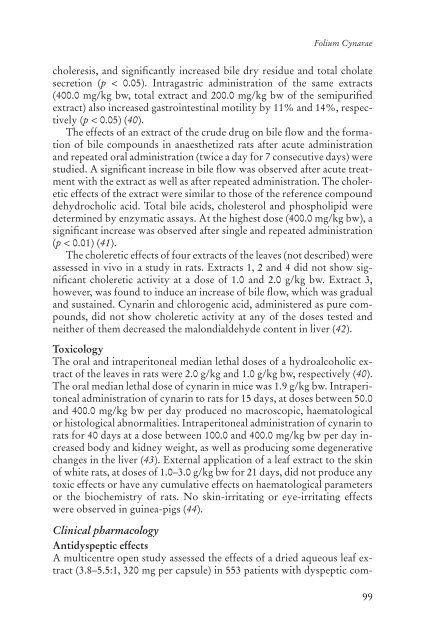WHO monographs on selected medicinal plants - travolekar.ru
WHO monographs on selected medicinal plants - travolekar.ru
WHO monographs on selected medicinal plants - travolekar.ru
You also want an ePaper? Increase the reach of your titles
YUMPU automatically turns print PDFs into web optimized ePapers that Google loves.
Folium Cynarae<br />
choleresis, and significantly increased bile dry residue and total cholate<br />
secreti<strong>on</strong> (p < 0.05). Intragastric administrati<strong>on</strong> of the same extracts<br />
(400.0 mg/kg bw, total extract and 200.0 mg/kg bw of the semipurified<br />
extract) also increased gastrointestinal motility by 11% and 14%, respectively<br />
(p < 0.05) (40).<br />
The effects of an extract of the c<strong>ru</strong>de d<strong>ru</strong>g <strong>on</strong> bile flow and the formati<strong>on</strong><br />
of bile compounds in anaesthetized rats after acute administrati<strong>on</strong><br />
and repeated oral administrati<strong>on</strong> (twice a day for 7 c<strong>on</strong>secutive days) were<br />
studied. A significant increase in bile flow was observed after acute treatment<br />
with the extract as well as after repeated administrati<strong>on</strong>. The choleretic<br />
effects of the extract were similar to those of the reference compound<br />
dehydrocholic acid. Total bile acids, cholesterol and phospholipid were<br />
determined by enzymatic assays. At the highest dose (400.0 mg/kg bw), a<br />
significant increase was observed after single and repeated administrati<strong>on</strong><br />
(p < 0.01) (41).<br />
The choleretic effects of four extracts of the leaves (not described) were<br />
assessed in vivo in a study in rats. Extracts 1, 2 and 4 did not show significant<br />
choleretic activity at a dose of 1.0 and 2.0 g/kg bw. Extract 3,<br />
however, was found to induce an increase of bile flow, which was gradual<br />
and sustained. Cynarin and chlorogenic acid, administered as pure compounds,<br />
did not show choleretic activity at any of the doses tested and<br />
neither of them decreased the mal<strong>on</strong>dialdehyde c<strong>on</strong>tent in liver (42).<br />
Toxicology<br />
The oral and intraperit<strong>on</strong>eal median lethal doses of a hydroalcoholic extract<br />
of the leaves in rats were 2.0 g/kg and 1.0 g/kg bw, respectively (40).<br />
The oral median lethal dose of cynarin in mice was 1.9 g/kg bw. Intraperit<strong>on</strong>eal<br />
administrati<strong>on</strong> of cynarin to rats for 15 days, at doses between 50.0<br />
and 400.0 mg/kg bw per day produced no macroscopic, haematological<br />
or histological abnormalities. Intraperit<strong>on</strong>eal administrati<strong>on</strong> of cynarin to<br />
rats for 40 days at a dose between 100.0 and 400.0 mg/kg bw per day increased<br />
body and kidney weight, as well as producing some degenerative<br />
changes in the liver (43). External applicati<strong>on</strong> of a leaf extract to the skin<br />
of white rats, at doses of 1.0–3.0 g/kg bw for 21 days, did not produce any<br />
toxic effects or have any cumulative effects <strong>on</strong> haematological parameters<br />
or the biochemistry of rats. No skin-irritating or eye-irritating effects<br />
were observed in guinea-pigs (44).<br />
Clinical pharmacology<br />
Antidyspeptic effects<br />
A multicentre open study assessed the effects of a dried aqueous leaf extract<br />
(3.8–5.5:1, 320 mg per capsule) in 553 patients with dyspeptic com-<br />
99

















